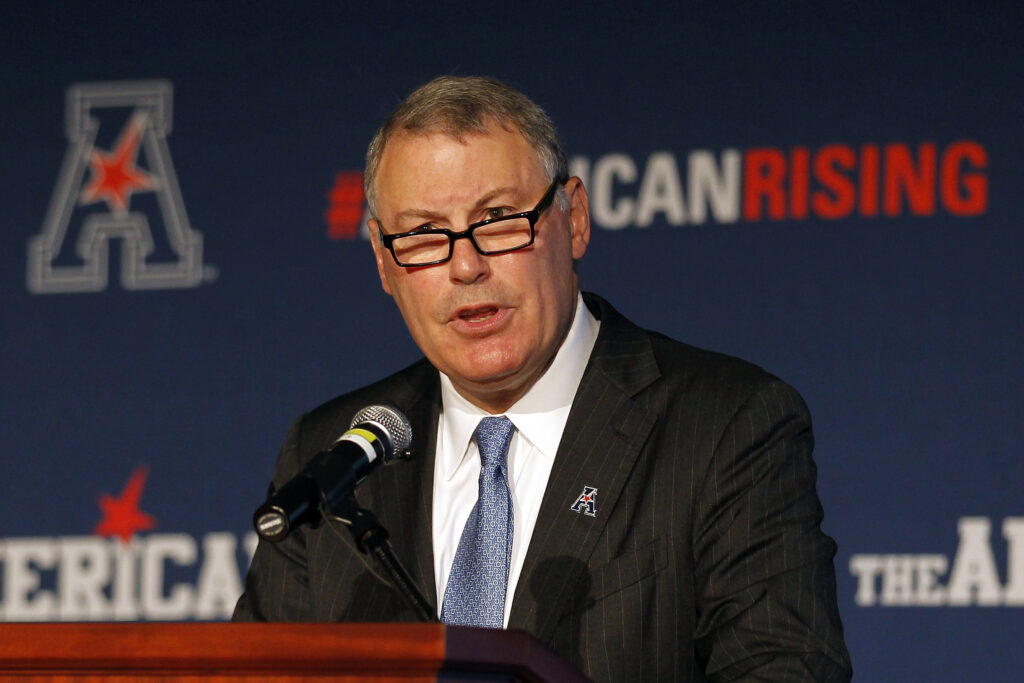AAC: Coordinated response needed to stabilize FBS
Newslooks- AP
Mike Aresco says athlete compensation, the transfer portal and conference realignment have created a perfect storm for an unsettled situation, and the American Athletic Conference commissioner believes all FBS conferences need to have a coordinated approach toward stability while finding a middle ground between an amateur model of college athletics and increasing professionalism.
“The amateur model we have embraced for decades is gone. We can’t pretend that it still exists,” he said Thursday. “But at the other end of the spectrum is pure NFL-style professionalism. Is that what we want? Is there a reasonable middle ground that retains the student-athlete experience and does not make our student-athletes employees or union members? I believe there is.”
Using prepared remarks in a nearly half-hour statement at the start of his league’s football media day, Aresco addressed key issues facing college sports. He described a pivotal moment with so many critical issues at the same time, including FBS conferences potentially splitting from the NCAA.
Aresco said football “is clearly a separate and distinct entity within the NCAA” that could benefit from its own governance structure. He said that makes sense because of the interconnection with the regular season and the College Football Playoff, but has to include all 10 FBS conferences, not only the Power Five leagues.
“The autonomy designation and conference governance model is no longer needed,” he said. “Disappearing along with it should be the Group of Five moniker. That label has been destructive. It should all be FBS, I’ve said it many times. The recent realignment of the past two years makes the autonomy concept and the accompanying Power Five media branding even less meaningful than it was before.”
While Aresco has long abhorred that G5 label, he acknowledged that reigning AAC champion Cincinnati last season becoming the first such team to make the College Football Playoff was “a singular and historic achievement.”
But the Bearcats are headed into their final AAC season before next summer joining with Houston and UCF into the Big 12. Six teams from Conference USA will move into the American at that time.
The Southeastern Conference and Big Ten are both set to expand to 16 teams. Oklahoma and Texas are going from the Big 12 to the SEC no later than the 2025 season. Southern Cal and UCLA in 2024 will leave the Pac-12 for the Big Ten, which will be a coast-to-coast conference stretching from Maryland to Southern California.
“We can lament realignment all we want, but we have to deal with it,” Aresco said. “The realignment we have seen is of course driven by money and competitive positioning. … Nevertheless, the health of our enterprise lies in the diversity of competition. We are not the NFL. We are not consolidated in one league or two leagues, regardless of that trend.”
Aresco expressed concern about a dramatic shift of conversations, which he said have been more about money and branding while the well-being of student-athletes is rarely mentioned.
“College football is entertaining and fun. Its popularity is clear and has been clear for some time,” Aresco said. “But will something irreplaceable be lost in this new world of super conferences and professionalized players?”
As for athletes being compensated for use of their names, images and likenesses, Aresco said that isn’t a bad thing if done properly.
“It wouldn’t be an issue if in fact it really was NIL. But it’s not at the current time,” he said. “We’ll have to see how the collectives that have been set up play out. Perhaps we can put some restrictions on them down the road, basically to ensure that NIL is rooted in a rational, fair-market value system. Otherwise, NIL is simply paying to entice recruits and paying to retain current roster players, regardless of their true NIL value.”
The CFP is still only four teams after a failed attempt to expand to a 12-team format before the current 12-year contract with ESPN expires after the 2025 season. But there is no playoff plan beyond that.
Aresco said it was shortsighted not to adopt a 12-team playoff that would have included the top six conference champions and six at-large teams. He said the recent realignment has only strengthened the need for that, or at least a similar model with a balanced mix of automatic spots for conference champions and at-large bids.
His ultimate goal is to get rid of the G5 label, saying the pending move for Cincinnati, Houston and UCF to the Big 12 only emphasizes that case.
“Houston and UCF were clearly playoff contenders during many of their years in our conference, as was Cincinnati, which actually made it last year,” Aresco said “Those teams were not given the respect they deserved over the years. But now that they’ve signed a piece of paper, they’re suddenly P5 and worthy of serious playoff consideration, according to various accounts I’ve read. Transformed by signing a piece of paper, it makes no sense. ”







